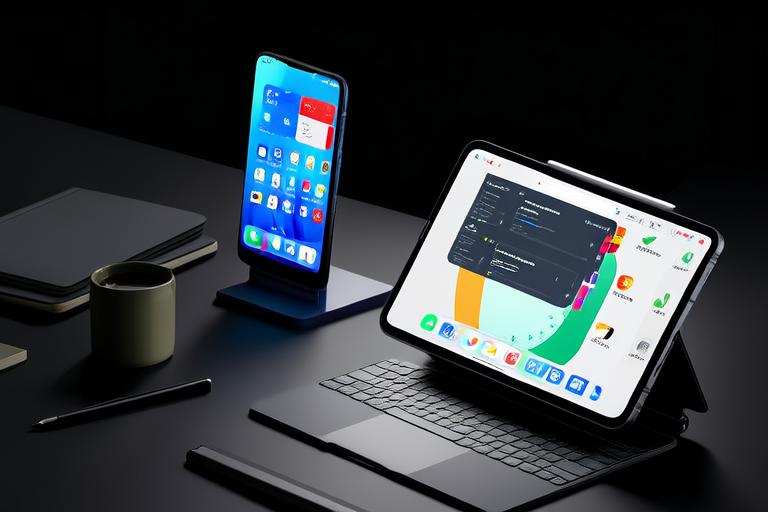“`html
How Smartphones and Tablets Are Redefining Productivity on the Go
Introduction
In today’s fast-paced world, smartphones and tablets have transcended their roles as mere communication tools. These devices have evolved into powerful productivity enablers, revolutionizing the way people work and manage their tasks. The concept of mobile productivity—working efficiently while on the go—has become increasingly significant in modern work environments. With the advent of advanced applications, cloud services, and connectivity, smartphones and tablets now offer unparalleled flexibility and efficiency.
This article explores how these devices are redefining productivity on the go, highlighting the transformative impact of mobile technology on work processes and professional lives. We will delve into the wide array of productivity tools, the role of cloud integration, the benefits of mobility and flexibility, and the latest technological advancements that continue to push the boundaries of what is possible.
Mobile Productivity Tools
The evolution of smartphones and tablets has been accompanied by the development of a vast array of productivity apps designed to streamline work processes and enhance efficiency. From task management to document editing, these tools cover a wide range of functionalities that cater to diverse professional needs.
Popular categories of productivity apps include task management tools like Trello and Asana, which help users organize projects and track progress. Note-taking apps such as Evernote and OneNote allow users to capture ideas and notes effortlessly, ensuring nothing is lost in transit. Document editing apps like Microsoft Office and Google Docs enable users to create, edit, and share documents seamlessly. Email clients and collaboration tools like Slack and Microsoft Teams facilitate communication and teamwork, making it easier to stay connected with colleagues regardless of location.
These apps have transformed the way professionals approach their work. By offering intuitive interfaces and robust functionalities, they empower users to stay organized and efficient while on the move. Whether it’s managing a project, drafting an important document, or collaborating with team members, these tools ensure that productivity remains uninterrupted.
Connectivity and Cloud Integration
One of the key factors driving the rise of mobile productivity is the seamless integration of high-speed internet and cloud services. Smartphones and tablets leverage these technologies to provide access to files and resources from anywhere, at any time.
Cloud storage services such as Google Drive and Dropbox play a pivotal role in this integration. They allow users to store and access files securely from any device, ensuring that important documents are always within reach. This level of accessibility is particularly beneficial for professionals who need to work remotely or from multiple locations.
Real-time collaboration features are another major advantage of cloud integration. Platforms like Google Docs and Microsoft OneDrive enable multiple users to edit and review documents simultaneously, fostering seamless teamwork. This capability is especially valuable in collaborative projects, where timely feedback and input are crucial.
Seamless integration between mobile and desktop platforms ensures a consistent user experience. Whether a user starts working on a document on their smartphone and continues on their laptop, or vice versa, the transition is smooth and efficient. This integration eliminates the need for manual file transfers and ensures that work can continue without interruption.
Mobility and Flexibility
The flexibility offered by smartphones and tablets is one of their most significant advantages. These devices allow professionals to work efficiently from various locations, whether it’s from home, a café, an airport, or even during commutes. The portability and convenience of having all necessary tools in one device make them indispensable for modern workers.
Freelancers, remote workers, and salespeople are among the professionals who have benefited most from mobile productivity. Freelancers can manage their projects and communicate with clients from anywhere, ensuring they remain productive even when not in a traditional office setting. Remote workers can collaborate with colleagues and attend meetings from home, reducing the need for travel and increasing work-life balance. Salespeople can access customer data and update records on the go, ensuring they are always prepared for client interactions.
The ability to work from multiple locations not only increases flexibility but also enhances overall productivity. By eliminating the constraints of a fixed workspace, professionals can optimize their schedules and make the most of their time. This flexibility is particularly valuable in today’s increasingly mobile workforce, where the ability to work from anywhere is becoming a necessity.
Technological Advancements
Recent technological advancements have further enhanced the capabilities of smartphones and tablets, contributing to their growing role in productivity. Innovations such as 5G networks, faster processors, larger displays, and improved battery life have significantly boosted performance and extended usage time.
5G networks, with their ultra-fast speeds and low latency, enable smoother and more reliable connections, facilitating real-time collaboration and seamless data transfer. Faster processors ensure that devices can handle complex tasks efficiently, allowing users to multitask without delays. Larger displays provide a more immersive experience, making it easier to view and interact with content. Improved battery life ensures that users can work for extended periods without interruptions.
Augmented Reality (AR) and Virtual Reality (VR) are emerging technologies that hold great promise for enhancing user experience and productivity. AR can be used to overlay digital information onto the physical world, providing contextually relevant insights and instructions. VR, on the other hand, offers immersive virtual environments that can simulate real-world scenarios, enabling more effective training and collaboration. These technologies have the potential to transform the way professionals approach tasks and collaborate, further boosting productivity.
Conclusion
In conclusion, smartphones and tablets have redefined productivity on the go by offering a wide range of productivity tools, seamless connectivity through cloud integration, unmatched mobility and flexibility, and cutting-edge technological advancements. These devices have become essential tools for professionals across various industries, enabling them to work efficiently and effectively from anywhere.
As technology continues to evolve, we can expect further innovations that will enhance the capabilities of mobile devices even more. The future of mobile productivity looks promising, with new trends and developments poised to have a significant impact on how we work. By embracing these advancements, professionals can unlock new levels of productivity and efficiency, ensuring they remain competitive in an ever-changing work environment.
“`


